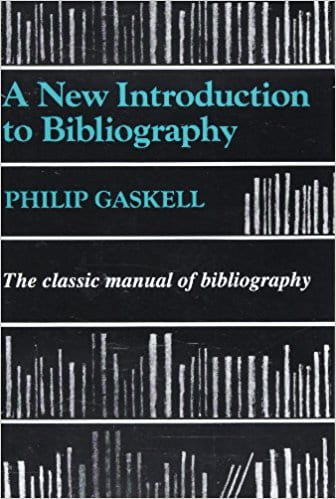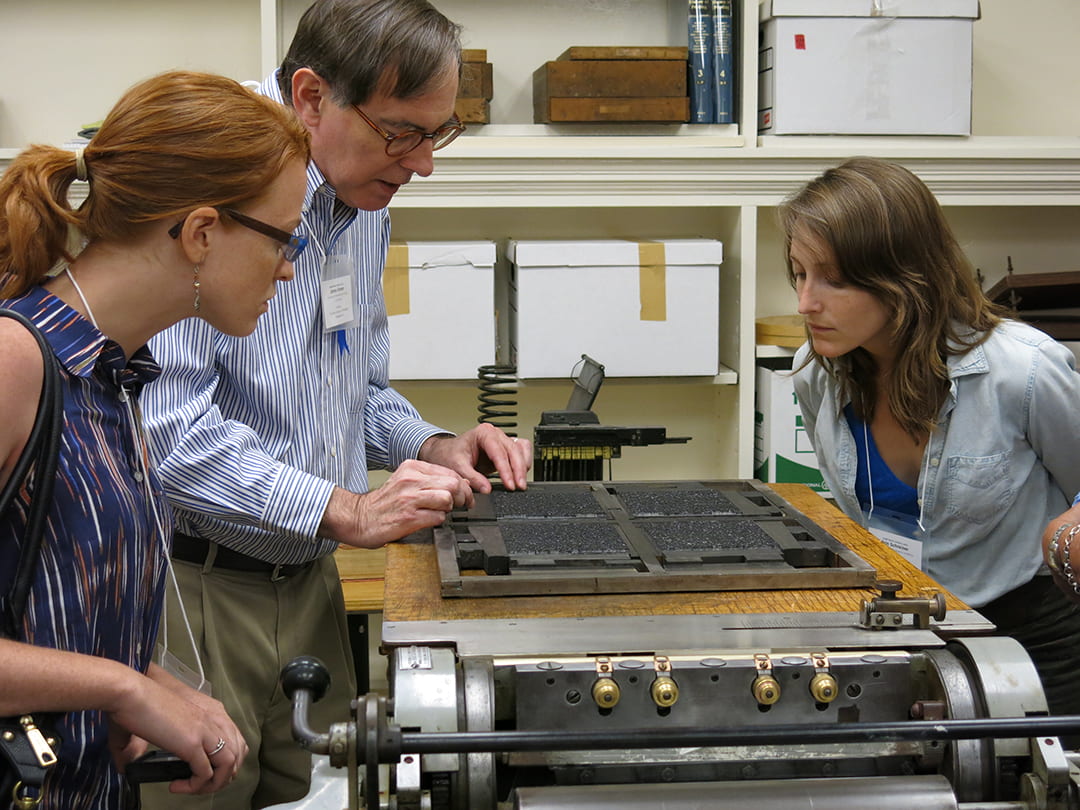By editor Erin McGuirl
This summer, I spent a week at Rare Book School at the University of Virginia doing something new and I loved it. I was a newcomer to a group of Lab Instructors guiding students through a weeklong intensive course, the Introduction to the Principles of Descriptive Bibliography, otherwise known as Des Bib boot camp. Through the course of the week, students spend a solid six-to-eight hours each day in lectures, curated museums of printing, typography, and paper, and in something of a trial by fire: homework and “lab” sessions. In the last two students go to battle with books, writing collational formulas and statements of signing and pagination that describe, in a language codified by Fredson Bowers, the book’s structure. In the lab periods, students sit down with an instructor to see if the descriptions they wrote actually represent the book at hand.
It’s this last bit that’s the trickiest part of learning to write coherent, accurate, and concise bibliographical descriptions, because in order to describe a book you’ve got to understand why it looks the way it does now, how and when it got to be that way, and the questions to ask and the sources to consult to figure all that stuff out. Determining book format – folio? quarto? octavo? duodecimo? 32mo or 24mo? – requires not just an understanding of what those words mean, but also a substantial knowledge of historical printing, papermaking, and binding techniques. In other words, competent bibliographical description depends upon competent bibliographical analysis, and students learn to do both in this course at Rare Book School. It’s a lot to teach, but students catch on fast and many have a lot of fun with it.
Most students in this course fall into three categories: rare book curators, library catalogers, and booksellers. Academics, typically historians of English literature, have also been a fixture in the course and in years past their numbers have grown, particularly thanks to Rare Book School’s Mellon Fellowship Program. Curators and booksellers must know how to read and write descriptions because their reputations, their livelihood, and the collections they help to build depend on it. The value of a book depends upon whether or not it is complete, and the place it holds within that text’s publication history. The edition, issue, or state of a specific copy of a text impacts its monetary and scholarly value, and parties on both ends of the transaction must carefully examine the book at hand in order to know precisely what is on offer. Catalogers, too, must learn to read and write descriptions so that they can accurately represent the book in their institution’s collection to the reading public consulting its catalog.
 For curators, catalogers, and booksellers, the need to read and write detailed, Bowers-style bibliographical descriptions brings them to Charlottesville for the week. And this, in part, explains why fewer academics (even academics who work in bibliographically oriented areas of study like the history of books and reading) typically take the course: reading and writing Bowers-style formulas is not an essential skill for their scholarship. But after a week of living and breathing the Rare Book School curriculum – which relies heavily on Bowers’ Principles of Bibliographical Description and Philip Gaskell’s A New Introduction to Bibliography – I want to urge academics to consider how learning the basics of descriptive bibliography can benefit your work as scholars and teachers.
For curators, catalogers, and booksellers, the need to read and write detailed, Bowers-style bibliographical descriptions brings them to Charlottesville for the week. And this, in part, explains why fewer academics (even academics who work in bibliographically oriented areas of study like the history of books and reading) typically take the course: reading and writing Bowers-style formulas is not an essential skill for their scholarship. But after a week of living and breathing the Rare Book School curriculum – which relies heavily on Bowers’ Principles of Bibliographical Description and Philip Gaskell’s A New Introduction to Bibliography – I want to urge academics to consider how learning the basics of descriptive bibliography can benefit your work as scholars and teachers.
At Rare Book School, students learn to write collations for what’s known as the ideal copy of the text, which Bowers defines as “a book which is complete in all its leaves as it ultimately left the printer’s shop in perfect condition and in the complete state that he considered to represent the final and most perfect state of it.” (Principles, 13) Perhaps the stickiest wicket in all of bibliography, ideal copy addresses what G. Thomas Tanselle describes as “a central truth that affects everything a bibliographer does… the fact that books are not meant to be unique items and are normally printed in runs of what purport [my emphasis] to be duplicates.”

Studying a forme of type on the bed of a Vandercook Press at Rare Book School.
But bookmakers and book buyers have many marvellous ways of interfering with the consistent reproduction and distribution of a text. In the print shop proofreaders stop the press to correct errors they’ve discovered during production, pieces of type break or fall out of place, and pressworkers lose focus and sheets are mislaid on the press. In the bindery, gatherings might be bound out of order, sheets from one book can be bound into another, or all together left out by accident. Readers, of course, do all kinds of things to their books – they tear leaves out and add leaves in, bind one book with a text to which it is completely unrelated as far as publication is concerned, and leave inked notes about the text or anything else in the margins and on blank pages. Analytical bibliography is the practice of discovering and diagnosing these kinds of issues; descriptive bibliography is the practice of synthesizing analytical observations and recording them accurately from copy to copy and across an edition.
When thinking like a descriptive bibliographer, one must consider such changes with respect to their impact on ideal copy, and with every book in hand one asks, “what do other copies look like and how many can I get my hands on?” This develops an essential scholarly habit of mind, specifically one in which the concept of ideal copy as it relates to a specific edition drives the very close examination and analysis of that text in multiple copies. By comparing a book in multiple copies and making sense of what one finds, the scholar bibliographer establishes a well researched and materially based context for their research. Understood in these terms, intellectual historians and historians of books and reading in particular can turn to analytical and descriptive bibliography to uncover the material context that defines a historical reader’s experience of a text on the micro- and macro- levels. This is particularly true when one’s use of descriptive bibliography incorporates the theoretical and practical approaches of scholars like Don McKenzie. His “Printers of the Mind” and Bibliography and the Sociology of Texts cleared a new path for the discipline by articulating some of the pitfalls of the method when used exclusively, without the kinds of archival and secondary sources that book historians rely upon to establish historical context for their reading of a text. A printer’s relationship with an author or bookseller, for example, might impact the printed text, and that relationship might be revealed in the author’s letters or booksellers ledgers. A careful analysis of bibliographical clues will aim to uncover such details, and an accurate bibliographical description will record those facts alongside a description of the printed traces of those contextual details with precision.
Close readers will have noticed that I’ve often used the word accurate in reference to description. An accurate description might seem like obvious necessity for the scholar bibliographer, but it is not often easily achieved. As a teacher of descriptive bibliography, I aim to provide students with the tools they need to make well reasoned decisions about what they know they can say about a book at hand, and how to communicate conjecture. At the copy specific level, this type of description is a useful tool for scholars as they study a text in multiple copies because it is helpful to have a tool handy for consistent notetaking about the books you see in far-flung libraries. But more broadly, it’s also a useful tool for teaching students how to build a strong argument (or recognize a weak one) using material and textual evidence, which in part depends upon one’s ability to recognize what one does not or cannot know.
When I talk to my students about writing collational formulas, I tell them that they are writing a condensed argument about the way this book is, and they can explain how that happened in longer form areas of their descriptions. In our lab sessions, we bounce from book to collation and back to book to see how the two match-up, studying the evidence and understanding what it can lead us to conclude – or not – about that object. And while we look to Bowers for guidance on how to write all this stuff out clearly and concisely, learning descriptive bibliography is not an exercise in slavish adherence to the rules of a system of notation devised by a scholar of Elizabethan drama, nor is it an applicable only to books of the handpress period. Learning descriptive bibliography is about learning to look at as many instantiations of a text as possible, and knowing how to identify, synthesize, and interpret the material evidence presented in each copy.
Those of you who have followed my writing for JHI Blog will know that I’m not particularly interested in handpress era books. I started collecting Whole Earth Catalogs some years ago because I found The Last Updated Whole Earth Catalog in a bookshop and read the “How to Make a Whole Earth Catalog” section as a guide to the bibliographical analysis of 20th century counter-culture books. I applied what I learned there to all kinds of twentieth-century printed matter I encounter in my personal and professional life. Without a background in descriptive bibliography, I wouldn’t have read it that way, or started seeing so much in a set of books that I was naturally curious about. Studying bibliography taught me to see more and more clearly, and I’m not the only one. There might be a whole new set of questions under your nose, just waiting for your to learn how to see them. As we tell our students in Des Bib, start reading Gaskell and see what you’ve been missing.


October 3, 2017 at 10:52 am
Reblogged this on Progressive Geographies and commented:
A fascinating post about descriptive bibliography – something else I’ve been thinking about with the Shakespeare work, and the use of archives and rare book rooms.